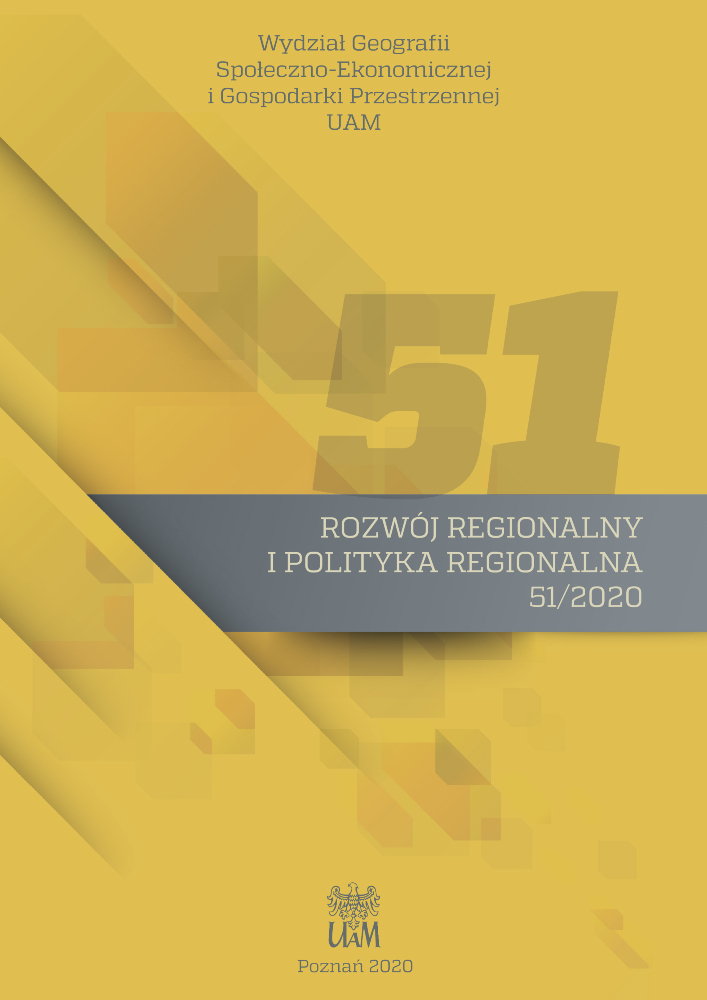Abstrakt
Pandemia COVID-19 wpłynęła na ograniczenie funkcjonowania większości ludzi do obszaru najbliższego sąsiedztwa. Stąd też społeczności lokalne stanęły przed wyzwaniem organizacji wzajemnego wsparcia i przepływu informacji w sytuacji kryzysowej. Celem opracowania jest identyfikacja głównych cech funkcjonowania mediów społecznościowych wrocławskich rad osiedli podczas trwania pandemii COVID-19. Analiza została przeprowadzona na podstawie najpopularniejszego w Polsce portalu społecznościowego – Facebooka. Badania polegające na analizie 46 profili wrocławskich rad osiedli umożliwiły m.in. identyfikację zmian czasowych w zakresie liczby oraz tematyki postów. Było to podstawą określenia najważniejszych prawidłowości w strategiach informowania mieszkańców o rozwoju sytuacji kryzysowej związanej z pandemią COVID-19, jak również ich reakcji na te działania.
Bibliografia
Allington D., Duffy B., Wessely S., Dhavan N., Rubin J. 2020. Health-protective behaviour, social media usage and conspiracy belief during the COVID-19 public health emergency. Psychological Medicine, 1–7.
Anderson M., Karami A., Bozorgi P. 2020. Social Media and COVID-19: Can Social Distancing be Quantified without Measuring Human Movements? arXiv preprint arXiv:2006.05316.
Aymerich-Franch L. 2020. COVID-19 lockdown: impact on psychological well-being and relationship to habit and routine modifications (https://psyarxiv.com/9vm7r/).
Beaunoyer E., Dupéré S., Guitton M.J. 2020. COVID-19 and digital inequalities: Reciprocal impacts and mitigation strategies. Computers in Human Behavior: 106424.
Bonsón E., Royo S., Ratkai M. 2015. Citizens’ engagement on local governments’ Facebook sites. An empirical analysis: The impact of different media and content types in Western Europe. Government Information Quarterly, 32(1): 52–62.
Brodeur A., Clark A., Flèche S., Powdthavee N. 2020. COVID-19, Lockdowns and Well-Being: Evidence from Google Trends. Working Paper 2004E, Department of Economics, University of Ottawa.
Chan J. 2020. Using Google Data to Understand Canadian Movement Reductions During the COVID- 19 Pandemic (http://dx.doi.org/10.2139/ssrn.3599227).
Chiou L., Tucker C. 2020. Social distancing, internet access and inequality. NBER Working Paper, 26982. National Bureau of Economic Research, Cambridge.
Farooq A., Laato S., Islam A.N. 2020. Impact of online information on self-isolation intention during the COVID-19 pandemic: cross-sectional study. Journal of Medical Internet Research, 22(5): e19128.
Favale T., Soro F., Trevisan M., Drago I., Mellia M. 2020. Campus Traffic and e-Learning during COVID- 19 Pandemic. Computer Networks, 176: 107290.
Granovetter M.S. 1973. The strength of weak ties. American Journal of Sociology, 78(6): 1360–1380.
Han X., Wang J., Zhang M., Wang X. 2020. Using Social Media to Mine and Analyze Public Opinion Related to COVID-19 in China. International Journal of Environmental Research and Public Health, 17(8): 2788.
Hansen D., Shneiderman B., Smith M.A. 2010. Analyzing social media networks with NodeXL: Insights from a connected world. Morgan Kaufmann, Burlington.
Hofmann S., Beverungen D., Räckers M., Becker J. 2013. What makes local governments’ online communications successful? Insights from a multi-method analysis of Facebook. Government Information Quarterly, 30(4): 387–396.
Janc K. 2017. Geografia internetu. Rozprawy Naukowe Instytutu Geografii i Rozwoju Regionalnego 41. IGRR UWr, Wrocław.
Janc K. 2019. Przestrzeń cyfrowa i internet jako przedmiot zainteresowań w badaniach geograficznych. Przegląd Geograficzny, 91(2): 21–37.
Jarynowski A., Wójta-Kempa M., Belik V. 2020. Trends in perception of covid-19 in polish internet (https://www.medrxiv.org/content/10.1101/2020.05.04.20090993v1).
Kim J., Hastak M. 2018. Social network analysis: Characteristics of online social networks after a disaster. International Journal of Information Management, 38(1): 86–96.
Lev-On A., Steinfeld N. 2015. Local engagement online: Municipal Facebook pages as hubs of interaction. Government Information Quarterly, 32(3): 299–307.
Martín Y., Li Z., Cutter S.L. 2017. Leveraging Twitter to gauge evacuation compliance: Spatiotemporal analysis of Hurricane Matthew. PLoS one, 12(7).
Misiak B., Szcześniak D., Kaczanowicz L., Rymaszewska J. 2020. The COVID-19 outbreak and Google searches: Is it really the time to worry about global mental health? Brain, Behavior, and Immunity, 87: 126–127.
Naeem S.B., Bhatti R., Khan A. 2020. An exploration of how fake news is taking over social media and putting public health at risk. Health Information & Libraries Journal, 10.1111/hir.12320.
Pennycook G., McPhetres J., Zhang Y., Lu J.G., Rand D.G. 2020. Fighting COVID-19 misinformation on social media: Experimental evidence for a scalable accuracy-nudge intervention. Psychological Science, 31(7): 770–780.
Rodriguez-Toubes D., Dominguez-Lopez Y. 2017. Social Media in Crisis Communication: German-wings Flight 4U9525. [W:] Media and Metamedia Management. Springer, Cham, s. 243–249.
Sharma M., Yadav K., Yadav N., Ferdinand K.C. 2017. Zika virus pandemic – analysis of Facebook as a social media health information platform. American Journal of Infection Control, 45(3): 301–302.
Shelton T., Poorthuis A., Graham M., Zook M. 2014. Mapping the data shadows of Hurricane Sandy: Uncovering the sociospatial dimensions of ‘big data’. Geoforum, 52: 167–179.
Silver A., Matthews L. 2017. The use of Facebook for information seeking, decision support, and self-organization following a significant disaster. Information, Communication & Society, 20(11): 1680–1697.
Stephenson J., Vaganay M., Coon D., Cameron R., Hewitt N. 2018. The role of Facebook and Twitter as organisational communication platforms in relation to flood events in Northern Ireland. Journal of Flood Risk Management, 11(3): 339–350.
Thelwall M., Thelwall S. 2020. Retweeting for COVID-19: Consensus building, information sharing, dissent, and lockdown life. arXiv preprint arXiv:2004.02793.
Wang Z., Ye X. 2018. Social media analytics for natural disaster management. International Journal of Geographical Information Science, 32(1): 49–72.
Xiao Y., Huang Q., Wu K. 2015. Understanding social media data for disaster management. Natural Hazards, 79(3): 1663–1679.
Yuan Y., Lu Y., Chow T.E., Ye C., Alyaqout A., Liu Y. 2020. The Missing Parts from Social Media-Enabled Smart Cities: Who, Where, When, and What?, Annals of the American Association of Geographers, 110(2): 462–475.
Zhou L., Wu S., Zhou M., Li F. 2020. ‘School’s Out, But Class’ On’, The Largest Online Education in the World Today: Taking China’s Practical Exploration During The COVID-19 Epidemic Prevention and Control As an Example. Best Evidence of Chinese Education, 4(2): 501–519.
Licencja
Prawa autorskie (c) 2020 Krzysztof Janc, Wojciech Jurkowski

Utwór dostępny jest na licencji Creative Commons Uznanie autorstwa 4.0 Międzynarodowe.

